
|
||
|
Portland art blog + news + exhibition reviews + galleries + contemporary northwest art
|
||
NCECA Roundup (Part 1)
The fact that the NCECA Conference brought several thousand people and over 100 ceramic-related art exhibitions to Portland for a period of four days in early March predictably elicited everything from enthusiasm to skepticism and indifference from Portlanders. Although the roots of Portland's craft tradition runs deep, it's not exactly at the forefront of the art scene here. The political and aesthetic radicalism that marked the Art & Craft Movement at the turn of the century has dwindled, and many now associate craft with fine (but not necessarily well-designed) objects. Since craft has historically been focused around specific media (glass, wood, fiber, metal, ceramic) and the idea of objects made by hand, it has not easily found a place within the dominant trends of contemporary art. Virtuosic art making has been dismissed in favor of conceptualism, genre-crossing and expansive practice. Furthermore, most who identify themselves as part of the crafts community—artists, writers and collectors alike—have eschewed theory and critical discourse, leaving craft at the fringe of mainstream dialog about contemporary art. Ceramics as a medium has not been widely adapted in broader contemporary art practice. Shows like the Attese Biennale of Ceramics in Contemporary Art are not common, nor is there a ceramic-based counterpart to Philadelphia's Fabric Museum & Workshop. There have been a handful of ceramic "ambassadors" to the contemporary art world over the years. Peter Voulkos, who appeared on the cover of Artforum in 1978, found resonance with Abstract Expressionism in his muscular vessels. More recently, Grayson Perry, winner of the 2003 Turner Prize, exploited the British love of shock through his elaborately decorated pots. However, ceramics remain largely ghettoized within contemporary art.
Against this backdrop, it is no surprise that certain members of Portland's art community balked at the idea of dozens of ceramic shows descending on the city in March. The NCECA conference itself pointed to one of the biggest challenges of a medium-based community—because the NCECA community is based solely on one's affiliation to the ceramic medium, everything from brown pots to slick installations have been ushered in under the umbrella of NCECA. The very good and the very bad can be seen alongside one anther this month around town. But, there is plenty of proof that NCECA did much more for Portland than bring a large clique of ceramic educators, artists and collectors to town.
THE NEW UTILITARIAN AT LEWIS & CLARK NCECA's invitational exhibition took on an ambitious theme—The New Utilitarian: Examining our Place on the Motherboard of Technology—which, unfortunately, never came to a sharp focus. Attempting to examine the link between ceramics and technology, the show was plagued by a shifting definition of the word "technology," and the resulting exhibition was inconsistent. The work of Paul McMullan—who employs technology by searching for mostly nostalgia-laden imagery on the web that he uses to decorate his hybrid cast sculptures—were alongside artists like Bennett Bean, who uses recent technologies from industrial fabrication to create ceramic knives.
Furthermore, curator Holly Hanessian took a rather ambiguous stance towards technology in her introductory remarks. Posing questions like, "Is it satisfying to spend hours at a computer?," her attempts to "address both sides of this question" about technology seemed to derive from a perceived antagonism between technology and ceramic artists. The truth is, ceramics have historically had a relationship to industrial applications. In the past several decades, this link has only grown as ceramic is now used for many ultra-precise, high-tech componant parts in addition to its more traditional use in mass-produced goods and tableware.
Despite the exhibition's failure to arrive at any clear conclusion about the relationship between the use of technology in ceramics, there were some interesting individual pieces to be found within the show. Garth Johnson, who authors Extreme Craft, parodied a nostalgic notion of the future and technology. A large grid of vintage Star Trek and NASA souvenir plates served as grounds for an overlay of an enlarged 50s-style science fiction illustration bearing the headline, "Captain Future." In his statement, Johnson writes, "We are living in a 21st Century where style doesn't resemble the Jetsons as much as it resembles the decade that spawned them." The decorative vessels of Sin-Ying Ho draw inspiration from mass-produced blue and white porcelain ware from her native China, but the inclusion of contemporary logos and binary code acknowledge the advent of globalization.
Charles Krafft's Spone™ Sentry Series uses the ancient technique of bone China, replacing the primary component with human bone ash from crematory remains. A series of shovels, bearing decorative crests in Delft-blue, continue Krafft's exploration of disaster, warfare and politics. A large retrospective of work by Akio Takamori surveys everything from his signature Picasso-esque "envelope" vessels to his more recent body of freestanding figures. Takamori gained prominance through his sculptural vessels, which depict voluptuous figurative forms, often in erotic embrace. While in residency at the European Ceramic Work Center in 1996, Takamori found a new direction for his work, deviating from the heavy modernist influences of his envelope vessels to create series of freestanding figurative sculptures.
Takamori's figures use the same rounded forms as his vessels, but his drawings are more narrative, stark black outlines reminiscent of early manga. The figures reference post-war imagery from his native Japan and more recently have evolved to cite icons of Western painting as well as icons from mass-produced Japanese porcelain ware. Showcasing Takamori's deft drawing skills, the figurative subjects are extracted from historical photographs, his own memories of post-war Japan and famous Old Master paintings. The figures stand approximately three feet high, an awkward and little used scale for the human figure, which is more often depicted at a one-to-one scale or the diminutive scale of figurines. By repositioning figures taken from two-dimensional sources into three-dimensional sculpture, Takamori forces the viewer to confront historical and personal memory through iconic subjects. [To be continued...] Posted by Katherine Bovee on March 24, 2006 at 10:29 | Comments (2) Comments This has been an exciting week for art in Portland. Lots of interesting pieces, and it seems virtually all of the NCECA work was atleast decent and enjoyable. Bean Finnernan's were very interesting. Beautiful really. Posted by: Calvin Carl I felt a top notch show with Ken Price, Jim Hodges, Jeff Koons and Melissa McGill would have exploded the ceramics as irrelevant to contemporary art myth. Still, Jeffrey Mitchell and Bean Finneran certainly make a strong case for that idea as a misconception. Besides so much of contemporary art is craft oriented these days, from Jim Drain, Lisa Lou, Phoebe Wahburn, Chandra Bocci and Hildur Bjarnadottir. With its prevalence I dont think there is an inherent animosity to craft per se from curators and sophisticated audiences. Really intellectual engagement... even if it is experiential, like Ken Price's work, is the litmus test. I look forward to part 2. Posted by: Double J Post a comment Thanks for signing in, . Now you can comment. (sign out)
(If you haven't left a comment here before, you may need to be approved by
the site owner before your comment will appear. Until then, it won't appear
on the entry. Thanks for waiting.)
|
| s p o n s o r s |
 |
 |
 |
 |
 |
 |
 |
 |
 |
 |
 |
 |
 |
 |

|
Site Design: Jennifer Armbrust | • | Site Development: Philippe Blanc & Katherine Bovee | |


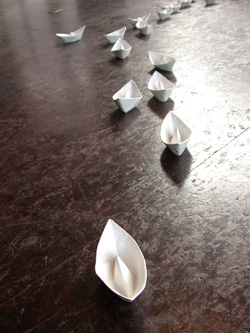
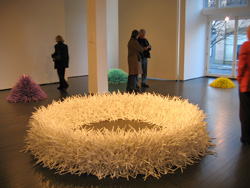
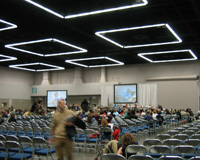
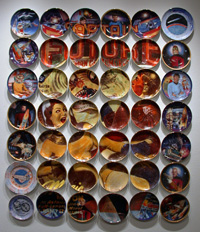
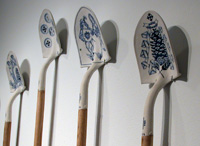
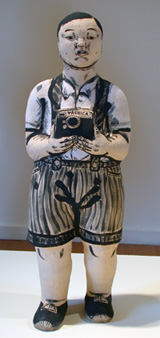
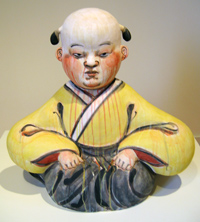
![[TypeKey Profile Page]](http://www.portlandart.net/nav-commenters.gif)